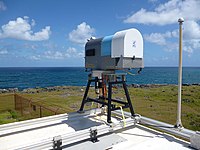
Photo from wikipedia
A simple integrated interferometer with an open cavity for salinity and temperature measurement is theoretically analyzed and verified in the article. The sensing probe consists of a small segment of… Click to show full abstract
A simple integrated interferometer with an open cavity for salinity and temperature measurement is theoretically analyzed and verified in the article. The sensing probe consists of a small segment of hollow core fiber (HCF) embedded in a pair of multimode fibers (MMFs) and is spliced to the light-guiding single-mode fiber (SMF), that is, the SMF–MMF–HCF–MMF–SMF (SMHMS) structure. The existence of the opening cavity makes it possible for Mach–Zehnder (MZ) and Fabry–Perot (FP) interference spectra to coexist in a single compact structure. The interferometer not only maintains the high sensitivity in salinity measurement with the MZ interferometer (MZI) but also obtains the spectrums of the MZI and FP interferometer (FPI) simultaneously, which is adequate to make a more precise measurement. In the experiment, the sensitivity of salinity can reach −3.2 nm/ ‰ in the salinity range of 0 $\unicode{0x2030}-40\,\,\unicode{0x2030}$ , at the same time, that of temperature can reach 1.64 nm/°C within 5 °C–30 °C. According to the different responses of two interferometers in one compact structure to salinity and temperature, the problem of cross-sensitivity can be solved. In addition, the proposed sensing probe has advantages in size, sensitivity, and multiparameter sensing.
Journal Title: IEEE Transactions on Instrumentation and Measurement
Year Published: 2023
Link to full text (if available)
Share on Social Media: Sign Up to like & get
recommendations!